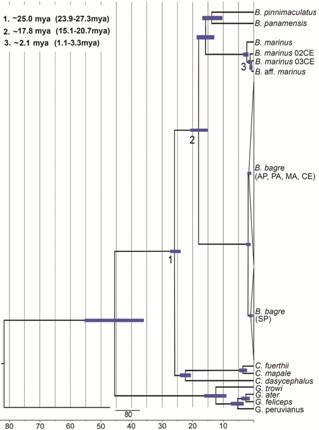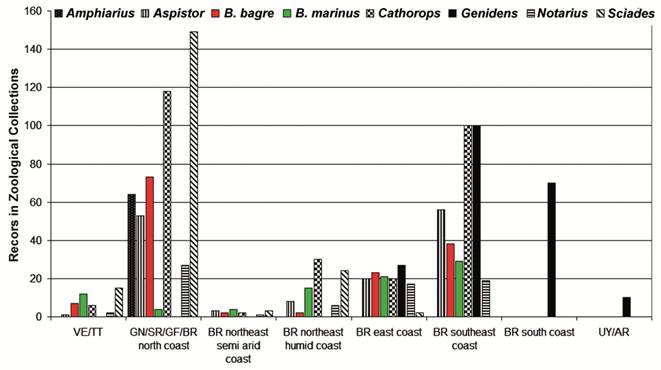|
B. bagre
|
Bbag012 (H 1) |
Bbag014, Bbag016, Bbag017, Bbag033, Bbag035, Bbag036, Bbag042, Bbag047, Bbag129, Bbag133, Bbag136, Bbag137, Bbag138, Bbag140, Bbag150, Bbag151, Bbag153, Bbag216, Bbag234, Bbag235, Bbag185, Bbag187, Bbag189, Bbag194, Bbag203, Bbag206, Bbag164, Bbag171, Bbag174, Bbag175, Bbag176, Bbag177, Bbag178, Bbag181. |
Macapá, AP, Bragança, PA, São Luis, MA, Fortaleza, CE. |
ATPase 8 and 6/ KU668591 |
|
B. bagre
|
Bbag025 (H2) |
Bbag026, Bbag077, Bbag218, Bbag232, Bbag122, Bbag190, Bbag195, Bbag202, Bbag204, Bbag236, Bbag167, Bbag172, Bbag179. |
Macapá, AP, São Luis, MA, Fortaleza,CE. |
ATPase 8 and 6/ KU668592 |
|
B. bagre
|
Bbag028 (H3) |
Bbag131, Bbag155, Bbag193. |
Bragança, PA, São Luis, MA. |
ATPase 8 and 6/ KU668593 |
|
B. bagre
|
Bbag126 (H4) |
Bbag126. |
Bragança, PA. |
ATPase 8 and 6/ KU668594 |
|
B. bagre
|
Bbag132 (H5) |
Bbag165, Bbag168. |
Fortaleza,CE. |
ATPase 8 and 6/ KU668595 |
|
B bagre
|
Bbag136 (H 6) |
Bbag136. |
Bragança, PA. |
ATPase 8 and 6/KU668596 |
|
B. bagre
|
Bbag229 (H 7) |
Bbag229. |
Bragança, PA. |
ATPase 8 and 6/KU668597 |
|
B. bagre
|
Bbag120 (H 8) |
Bbag121, Bbag163. |
São Luis, MA, Fortaleza, CE. |
ATPase 8 and 6/ KU668598 |
|
B. bagre
|
Bbag237 (H 9) |
Bbag237. |
São Luis, MA. |
ATPase 8 and 6/KU668599 |
|
B. bagre
|
Bbag166 (H 10) |
Bbag166. |
Fortaleza, CE. |
ATPase 8 and 6/KU668600 |
|
B. bagre
|
Bbag250 (H 11) |
Bbag251, Bbag252, Bbag254, Bbag256, Bbag257, Bbag258, Bbag259, Bbag260, Bbag262, Bbag264, Bbag265, Bbag267, Bbag268, Bbag269. |
Santos, SP. |
ATPase 8 and 6/KU668601 |
|
B. bagre
|
Bbag266 (H 12) |
Bbag266. |
Santos, SP. |
ATPase 8 and 6/KU668602 |
|
B. bagre
|
Bbag012 (H 1) |
Bbag016, Bbag017, Bbag033, Bbag 35, Bbag 36, Bbag 47 - AP); (Bbag 129, Bbag 131, Bbag 133, Bbag 134, Bbag 136, Bbag 137, Bbag 138, Bbag 150, Bbag 151, Bbag 153, Bbag 216, Bbag 218, Bbag 234 - PA); (Bbag 120, Bbag 185, Bbag 187, Bbag 189, Bbag 194, Bbag 203, Bbag 206, Bbag 237 - MA); (Bbag 164, Bbag 166, Bbag 171, Bbag 174, Bbag 175, Bbag 176, Bbag 177, Bbag 178 - CE) |
Macapá, AP, Bragança, PA, São Luis, MA, Fortaleza, CE. |
Cytb/KU668603 |
|
B. bagre
|
Bbag014 (H 2) |
Bbag014. |
Macapá, AP. |
Cytb/KU668604 |
|
B. bagre
|
Bbag025 (H 3) |
Bbag025. |
Macapá, AP. |
Cytb/KU668605 |
|
B. bagre
|
Bbag026 (H 4) |
Bbag026. |
Macapá, AP. |
Cytb/KU668606 |
|
B. bagre
|
Bbag028 (H 5) |
Bbag122, Bbag193. |
São Luis, MA. |
Cytb/KU668607 |
|
B. bagre
|
Bbag042 (H 6) |
Bbag042. |
Macapá, AP. |
Cytb/KU668608 |
|
B. bagre
|
Bbag077 (H 7) |
Bbag126, Bbag190, Bbag 202, Bbag 236, Bbag167, Bbag172, Bbag179. |
Bragança, PA, São Luis, MA, Fortaleza, CE. |
Cytb/KU668609 |
|
B. bagre
|
Bbag132 (H 8) |
Bbag165, Bbag168. |
Fortaleza, CE. |
Cytb/KU668610 |
|
B. bagre
|
Bbag140 (H 9) |
Bbag155. |
Bragança, PA, |
Cytb/KU668611 |
|
B. bagre
|
Bbag229 (H 10) |
Bbag121, Bbag163. |
São Luis, MA, Fortaleza, CE. |
Cytb/KU668612 |
|
B. bagre
|
Bbag232 (H 11) |
Bbag204, Bbag181. |
São Luis, MA, Fortaleza, CE. |
Cytb/KU668613 |
|
B. bagre
|
Bbag235 (H 12) |
Bbag235. |
Bragança, PA. |
Cytb/KU668614 |
|
B. bagre
|
Bbag195 (H 13) |
Bbag195. |
São Luis, MA. |
Cytb/KU668615 |
|
B. bagre
|
Bbag250 (H 14) |
Bbag251, Bbag252, Bbag254, Bbag257, Bbag258, Bbag259, Bbag260, Bbag 262, Bbag 264, Bbag 266 , Bbag 267, Bbag 268, Bbag 269 . |
Santos, SP. |
Cytb/KU668616 |
|
B. bagre
|
Bbag256 (H 15) |
Bbag256 |
Santos, SP. |
Cytb/KU668617 |
|
B. bagre
|
Bbag265 (H 16) |
Bbag265. |
Santos, SP. |
Cytb/KU668618 |
|
B. marinus
|
Bma02 (H 1) |
Bma02, Bma03 |
Fortaleza, CE. |
ATPase 8 and 6/ KU730294 |
|
B. marinus
|
Bma02 (H 1) |
Bma02, Bma03 |
Fortaleza, CE. |
Cytb/KU720393 |

 Thumbnail
Thumbnail
 Thumbnail
Thumbnail
 Thumbnail
Thumbnail
 Thumbnail
Thumbnail
 Thumbnail
Thumbnail
 Thumbnail
Thumbnail
 Thumbnail
Thumbnail






